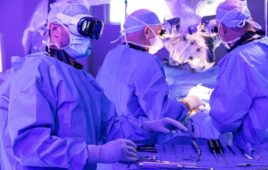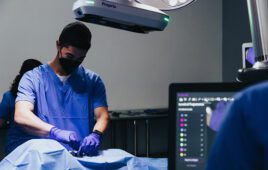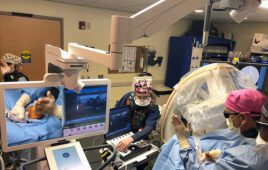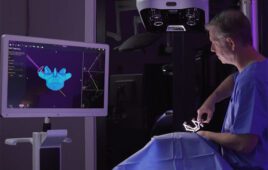
Primary cortical neurons cultured on the surface of an array of optoelectronic nanowires. Here a neuron is pulling the nanowires, indicating the the cell is doing well on this material. [Image from UC San Diego]
This is not the first example of prosthetic retinas. Current retinal prostheses restore vision, but the technology still has its limits under the acuity threshold of 20/200 vision.
With the new UC San Diego–Nanovision technology, the arrays of silicon nanowires sense light and electrically stimulate the retina. The nanowires have a high-resolution that is similar to the spacing of photoreceptors in human retinas. The other part of the technology consists of a wireless device that transmits power and data to the nanowires.
The new system differs from other retinal prostheses because it does not need a vision sensor outside of the eye. Vision sensors usually capture a visual scene and create signals that stimulate the neurons. The UC San Diego system uses the silicon nanowires to replicate the light-sensing cones and rods that are in the retina and stimulates the retinal cells. The nanowires create a grid of electrodes that get activated by light and are powered by a wireless electrical signal, which makes the electrodes highly-sensitive.
“To restore functional vision, it is critical that the neural interface matches the resolution and sensitivity of the human retina,” said Gert Cauwenberghs, a bioengineering professor at the Jacobs School of Engineering at UC San Diego and the paper’s senior author, in a news release.
It is estimated that about 285 million people have some form of vision impairment in the world, according to the World Health Organization. Of that number, 39 million are considered blind and 246 have low vision. However, 80% of all vision impairment can be prevented or cured.
An inductive powering telemetry system delivers wireless power to the implant from outside the body. The device, created by a Cauwnberghs-led team, is designed to be highly energy efficient and reduce the energy lost during wireless powering and data transmission while stimulating. It also recycles electrostatic energy that circulates in the inductive resonant tank and between capacitance in the electrodes and resonant tank.
Up to 90% of the transmitted energy is used to stimulate the retinal prostheses, generating less radiation being emitted from RF wireless power in the transmission and less heating to tissues.
The telemetry system can also transmit power and data through a pair of inductive coils, one on the outside of the body and one from the inside of the eye. It sends and receives 1 bit of data for every 2 cycles of the 1356 megahertz RF signal. Other retinal prostheses systems need 5 cycles for every 1 bit transmitted.
Researchers put the nanowire array into a transgenic rat retina with rhodopsin P23H knock-in retinal degeneration. When the prosthesis experienced light and electrical potential, horizontal and bipolar neurons fired action potentials. They did nothing when there was no light or electrical activity.
Nanovision Biosciences wants to further develop this technology for clinical use and hopes to restore functional vision in people who have severe retinal degeneration.
“We have made rapid progress with the development of the world’s first nanoengineered retinal prosthesis as a result of the unique partnership we have developed with the team at UC San Diego,” said Scott Thorogood, co-founder and CEO of Nanovision Biosciences.
The research was funded by Nanovision Biosciences, Qualcomm and the Institute of Engineering in Medicine and the Clinical and Translational Research Institute at UC San Diego. It was published in the Journal of Neural Engineering.
[Want to stay more on top of MDO content? Subscribe to our weekly e-newsletter.]




